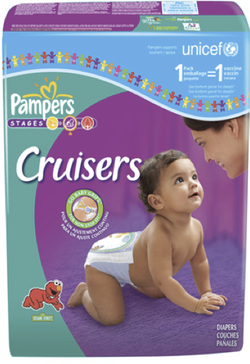
This is an example of how companies support charities by establishing partnerships with charities such as P&G and UNICEF. It's a great marketing tool and a way to support large impact causes.
Although I believe that this is remarkable and very useful, I see some limitations:
1. It cannot be done too often. Otherwise, it is perceived as a truly marketing tool and people might even doubt about its effectiveness.
2. It does not provide a measurement of the progress of the campaign and if its expected impact has been achieved.
3. It must be "relevant" to the product. If the company sells, for instance, shoe-shine cream, what could be the the counterpart donation?
4. The customer does not choose what charity to help. In the case of Pampers, UNICEF is of course a great and probably obvious choice. But it is this always the case? What if the customer would like to support other causes?
5. The same type of campaign cannot be done by competitors. Suppose that both Pampers and Huggies would do the same? That would be great for UNICEF. But the customer would see this as "matching" a product-feature by the second arrived.
I believe that these initiatives should remain, especially for very large scale projects. But companies should think about alternative ways to perform CSR, for example, by supporting the causes that their customers have chosen to support.
Although I believe that this is remarkable and very useful, I see some limitations:
1. It cannot be done too often. Otherwise, it is perceived as a truly marketing tool and people might even doubt about its effectiveness.
2. It does not provide a measurement of the progress of the campaign and if its expected impact has been achieved.
3. It must be "relevant" to the product. If the company sells, for instance, shoe-shine cream, what could be the the counterpart donation?
4. The customer does not choose what charity to help. In the case of Pampers, UNICEF is of course a great and probably obvious choice. But it is this always the case? What if the customer would like to support other causes?
5. The same type of campaign cannot be done by competitors. Suppose that both Pampers and Huggies would do the same? That would be great for UNICEF. But the customer would see this as "matching" a product-feature by the second arrived.
I believe that these initiatives should remain, especially for very large scale projects. But companies should think about alternative ways to perform CSR, for example, by supporting the causes that their customers have chosen to support.
 RSS Feed
RSS Feed
